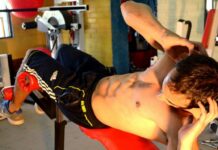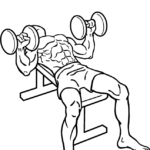If you are a fan of fitness or the gym, you have surely heard about hypopressive abs for some time. It is very likely that you are not sure what these new abs look like and why they are so fashionable. It is usually said that hypopressive abdominals were discovered in the eighties of the last century and that the discoverer was Dr. Marcel Curies during his studies and research on urn-gynecological rehabilitation. Actually this is not accurate. Dr. Curies did realize the potential of these abdominals in rehabilitations of this type, but in reality this type of exercise has a tradition of millennia, since it has been practiced for centuries throughout Asia, since they are a fundamental part of some types of yoga.

Doing hypopressive crunches is a totally different exercise from the traditional crunches that we all know. The latter are based on training the abdominals through physical stimulation through movement. However, when doing hypopressive sit-ups, what we do is stimulate this area of our body through our breathing. Doing hypopressive sit-ups offers great benefits to athletes as it allows you to expand your lung capacity reduce your waistline and strengthen your pelvic floor. The last two features of these sit-ups explain why they are often used for postpartum recovery... The strengthening of the pelvic floor occurs reflexively through the postures and breathing typical of this type of abdominal. If you would like to start doing hypopressive crunches but you are not sure how to do them, you are in luck since we will explain it to you step by step below.
What do you need to do hypopressive abs?
- mat yoga
- Comfortable clothes
- to mirror
Instructions for doing hypopressive crunches
- Once you have decided to take the plunge and encourage yourself to try hypopressive sit-ups -which I recommend since it is an exercise with many benefits- you must bear in mind that the most important thing to do correctly is the correct position. For this reason, all your interest should be located in the body position that you must acquire. There are many postures to do this type of sit-ups, but all of them have a series of points in common that are the ones that make the exercise have the desired effect. For this reason I am going to insist a lot on each one of them, although I will also explain, at the end of the article, some of the most common positions.
- First of all you must acquire a relaxed posture. The first posture you are going to do will be standing. In this way you will be able to pay attention to every detail and later when you are able to repeat the posture with ease you will be able to perform other more complicated postures. Stand with your feet about shoulder-width apart.
- Pay close attention to your pelvis. To do hypopressive crunches you will have to bring it forward slightly to, in this way, stimulate the pelvic floor. The best way to do this correctly is by trying to visualize your tailbone. The coccyx is the last bone of the spine. It is slightly curved and usually points downwards. You want it to point slightly forward. As you may have noticed when trying to do this your pelvis will have moved slightly forward. This is the position you should try to maintain at all times.
- Now look at your shoulders. You should try to throw them back a little but without changing the rest of your posture. Just bring them slightly back. You will notice how your chest moves forward when doing it and how your lung capacity widens
- Next you need to pay attention to your chin, which should point slightly down. You should point it towards your neck. Remember that the movement should be very light and at no time should you feel muscle tension.
- Lastly, you should bring your whole body slightly forward. Normally our body is placed perpendicular to the ground, forming an angle of ninety degrees. You should lean slightly forward (without losing your balance).
- You are now ready to start the exercise.
- The first key to performing these sit-ups is posture, as I told you before. The second is breathing, as you may have imagined. What you should try to do is inhale as much air as possible through your nose. When your lungs are full you must block the entry and exit of air (in your first attempts, to understand the movement well you can help yourself by covering your nose) and pretend to try to breathe. By doing this while your breathing tubes are closed, you will notice how all the air inside you rises to the top of your lungs. That is the desired movement that will help us so much. When this elevation occurs, your rib cage expands its capacity. On the contrary, the lower part of your lungs contracts and retracts inward. As you may have noticed, this area coincides with your abs.
- Observe yourself in a mirror. This will help you understand the movement. Your abdominals should be drawn in and you will notice that the contour of your waist has been reduced. However the ribcage and chest are fully expanded and full of air.
- You want to keep the air trapped for as long as you can. The more the better. When you need to breathe, expel all the air through your mouth and relax your entire posture.
- Do several repetitions.
- This is the most common position, but there are others that we detail below.
- On all fours: resting on the ground with our hands and knees. Remember to push your pelvis forward, roll your shoulders back, and lower your chin. These three points must be repeated in all postures
- Face up: with the knees bent and the feet flat on the ground. We will raise our arms towards the ceiling and place our palms at a ninety degree angle parallel to the ceiling. You should think that you are exerting force against something, as if you were trying to lift or support the ceiling.
- On your knees: with your arms extended at a ninety-degree angle and your hands raised with your hands parallel to the wall. Imagine that you are pushing against the wall. Also remember to lean slightly forward like when you did the first foot pose.
- There are many more positions. You can do them at the time you progress in your training. Always remember to maintain the three fundamental position points and lean forward.
Tips for doing hypopressive abs
- During the first few days of doing hypopressive sit-ups, it is quite common for you to feel dizzy. This is due to the respiratory effort you are carrying out. You should not be scared as it is very normal. You just have to take a little break.

















